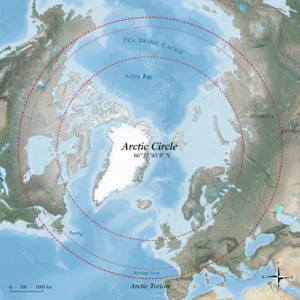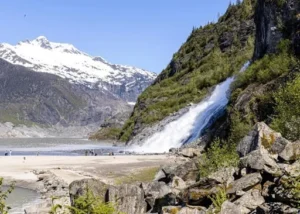Most Alaskan citizens reside in cities, villages, and clustered groups unfold across the country’s considerable expanse. Much of the land is owned by either the federal government, the kingdom government, or Alaska Native agencies, all of which impose diverse regulations on settlement.
Private land possession is debited for just one percent of the nation’s territory except for those entities. Well-known populace centers in Alaska’s economy showcase low to slight density, with expansive stretches of uninhabited land surrounding them.
In 2018, Alaska’s gross home product (GDP) reached $53.1 billion inflation-adjusted, barely growing from the preceding 12 months’s $52.7 billion. However, this figure remains notably beneath the height of $ 57 billion in 2012. While the state stays closely reliant on the oil and fuel industry, its dependence has gradually diminished. The non-oil GDP has also experienced large growth in recent years, largely compensating for the decline in oil-associated GDP.
Following three years of employment decline from late 2015 to late 2018, Alaska has seen a gradual increase in job opportunities, albeit at a modest rate of below one percent, throughout 2019. Economists anticipated further growth in 2020; however, the pace is expected to slow considerably to just 0.3 percent.
Alaska’s economy benefits significantly from federal spending, surpassing most other states. This is attributed partly to the extensive federal management of resources throughout the state. Furthermore, Alaska hosts a considerable Army, Air Force, and Coast Guard presence, from Fairbanks north to Sitka, Juneau, and Kodiak south. Notably, Alaska boasts the highest number of veterans per capita compared to any other state in the nation.
Alaska’s WIOA Areas, Planning Regions, and Economic Districts

Alaska operates under a unified WIOA area covering the entire state. However, operationally, the state is divided into distinct economic regions per its delineation.
These regions— Gulf Coast, Interior, Northern, Southeast, and Southwest—are utilized for labor market data collection, analysis, and planning.
Regional long-term occupational projections for Alaska’s economy are not generated. However, broad conclusions can be inferred from regional data, encompassing current and historical employment figures across various industries.
1- Southeast Regions
Although certain areas are remote and rural in the Gulf Coast and Southeast Regions, the job composition remains relatively consistent with statewide trends. Coastal regions tend to have a higher concentration of fishing, maritime transportation, and boat-building jobs, alongside a consistent growth in healthcare services driven by stable or expanding populations. Moreover, the distribution of government and private sector support roles in retail, hospitality, construction, and transportation shows little variation in areas with population centers of 10,000 or more
2- Northern Regions
The Northern Region hosts the majority of Alaska’s prominent oil and gas industry, encompassing the renowned Red Dog Mine, recognized as one of the world’s largest zinc mines.
Consequently, this area thrives on employment opportunities within the oil, gas, and mining sectors, alongside a significant presence of construction and transportation roles supporting these industries.
Increased activity in oil and gas results in a surge of jobs in food services, healthcare, and custodial services. Conversely, downturns in activity lead to corresponding reductions in employment opportunities.
The area witnessed a decline in oil and gas jobs from nearly 10,000 in 2015 to as low as 5,900 in 2018, earlier than steadily rebounding to the cutting-edge level of about 6,500. The ripple impact of activity losses inside the oil and gas enterprise is felt across the state due to a giant portion of people commuting from other elements of Alaska and the considerably excessive average wages, which stood at $112,000 in 2018.
3- Interior Region
The Interior Region boasts diverse resource industries, including large coal and gold mines.
Additionally, it is renowned for Denali National Park, which generates many seasonal jobs alongside a smaller number of year-round positions.
One exquisite financial spotlight in recent years has been the guidance for the arrival of new squadrons of F-35s scheduled for 2020-2021. This initiative is expected to have injected over $500 million into the economy through production-related expenditures.
4- Southwest region
In the Southwest region, the northern two census areas have consistently reported some of the highest unemployment rates in Alaska and the nation.
In recent years, the Bethel Census Area recorded an average monthly unemployment rate of 13.5 percent, persisting above 12 percent throughout the year. Even more striking were the rates in the Kusilvak Census Area (formerly the Wade Hampton Census Area), which reached 20.3 percent.
Employment opportunities in these areas predominantly stem from local government positions and support sector roles in populated areas, including healthcare, retail, construction, and transportation. Unlike the southern parts of the region, the northern boundaries of the Southwest Region do not experience significant benefits from commercial fishing activities.
Alaska’s Future Economic Prospects
Looking ahead in the longer term, following the adjustment to significantly reduced average oil revenues, the primary catalyst for potential Alaska economic transformation in Alaska would be the realization of an Alaska LNG export initiative.
This project entails the construction of a North Slope gas conditioning plant, a natural gas pipeline, and a liquefaction plant in Southcentral Alaska’s economy. If undertaken, these projects would be of immense scale, with an estimated combined cost ranging from $45 billion to $65 billion.
Should the project progress according to the current timeline, employment in the construction phase could peak around 2024 and 2025, with approximately 6,500 jobs expected.
Furthermore, the subsequent revenues generated by the state from its ownership stake in the project and LNG sales could reach up to $2 billion, thereby providing sustained economic stimulation for Alaska in the long run.












